Ah, Italian pizza! There’s something magical about it, right? Have you ever wondered why it tastes so heavenly? Or why it is even called pizza in the first place?
Well, it’s all about the toppings, my friend! Italian pizza toppings are not just ingredients; they’re a testament to Italy’s rich culinary heritage.
In this article, we’ll embark on a delicious journey exploring these traditional toppings that make Italian pizza a world-renowned delight.
What Are The Most Popular Italian Pizza Toppings?
When it comes to Italian pizza, each topping is a burst of flavor and tradition. Here’s a rundown of the top toppings that grace Italian pizzas, each adding its unique touch to this timeless dish:
- Tomato Sauce: The quintessential base for most pizzas. Made from either fresh or canned tomatoes, it’s seasoned with garlic, salt, and a medley of herbs. It sets the stage for other toppings to shine.
- Mozzarella Cheese: The star of Italian cheeses! Made from either buffalo or cow’s milk, it has a delightfully soft and stretchy texture that’s a dream on pizzas.
- Basil: This fragrant herb is a game-changer. It adds a dash of freshness and a pop of green, often found lounging on top of tomato sauce and mozzarella cheese.
- Olive Oil: More than just an oil, it’s a flavor enhancer. Drizzled over pizza either before or after baking, it adds a subtle depth of flavor and keeps the pizza moist.
- Olives: Whether you go for black or green, whole or sliced, olives bring a salty and tangy kick. They’re a great partner to cheese and ham.
- Ham: A meaty favorite! Whether cured or cooked, ham adds a layer of protein and a hint of saltiness, often accompanied by cheese and mushrooms.
- Mushrooms: Fresh or canned, these earthy delights add a savory note. They’re a classic pairing with cheese and ham.
- Salami: This cured sausage packs a punch with its spicy and smoky flavor. It’s a hit when teamed up with cheese and peppers.
- Peppers: Bringing a splash of color and a sweet crunch, peppers in red, green, or yellow are a perfect match with cheese and salami.
- Anchovies: These small salted fish are a bold choice, delivering a strong, salty flavor. They’re typically paired with cheese and capers.
- Capers: Tiny but mighty, these pickled flower buds add a sour and tangy zing, often accompanying cheese and anchovies.
- Artichokes: These edible flower buds contribute a nutty, creamy taste, commonly paired with cheese and ham.
- Eggplant: This purple veggie offers a soft, smoky flavor, often found alongside cheese and tomato sauce.
- Spinach: A green, leafy veg that’s not just healthy but adds a mild, nutritious flavor, usually paired with cheese and ricotta.
- Ricotta: A fresh cheese made from whey, it brings a light, creamy taste to the table, often found with cheese and spinach.
- Parmesan: A hard cheese from cow milk, known for its sharp, nutty flavor. It’s typically grated over the pizza after baking.
- Pecorino: Made from sheep milk, this hard cheese adds a salty, tangy dimension, often grated over the pizza as well.
- Gorgonzola: A type of blue cheese that’s bold and pungent, usually paired with cheese and walnuts for a flavorful twist.
- Walnuts: These nuts add a crunchy, slightly bitter note, often paired with cheese and gorgonzola for a unique taste.
Iconic Pizzas and Italian Pizza Toppings
Pizza Margherita: The Classic
Ah, Pizza Margherita – the epitome of Italian pizza, a timeless classic that’s as simple as it is delicious. This iconic pizza holds a special place in Italy’s culinary history, and its story is as rich as its flavor.
Picture this: the year is 1889, and Queen Margherita of Italy visits Naples. To honor her, a local pizzaiolo creates a pizza that embodies the colors of the Italian flag. The result? A stunning, simple yet flavorful pizza with red tomato sauce, white mozzarella cheese, and green basil leaves. This pizza, named after the Queen herself, has since become a symbol of Italian culinary excellence.
The Toppings
- Tomato Sauce: The base layer of the pizza, rich, vibrant, and bursting with flavor. It’s the red in our edible Italian flag.
- Mozzarella Cheese: Soft, creamy, and melt-in-your-mouth delicious. This cheese adds the white element, representing purity and simplicity.
- Basil Leaves: Fresh, aromatic, with a hint of sweetness and peppery edge. The basil leaves are the green touch, adding a splash of color and freshness.
- Olive Oil: A drizzle of olive oil is the final touch, bringing everything together with its subtle, fruity notes.

Pizza Margherita isn’t just food; it’s a piece of Italian heritage. Each ingredient is carefully chosen and expertly assembled to create a dish that’s deceptively simple but brimming with flavor. It’s a testament to the idea that sometimes, less truly is more.
This pizza is not just a favorite in Italy but has won hearts all over the world. Its universal appeal lies in its simplicity and the perfect harmony of its few ingredients. Whether you’re a pizza connoisseur or just someone who appreciates good food, the Pizza Margherita is a must-try – a slice of Italian history on your plate.
Pizza Marinara: Simplicity at Its Best
When we talk about the roots of Italian pizza, we inevitably stumble upon the humble yet magnificent Pizza Marinara. This dish, steeped in history, is a testament to the beauty of simplicity in Italian cooking.
Let’s set the scene: the 18th century, a bustling Naples, where sailors (marinai) return from their voyages at sea. They bring with them a craving for something hearty yet simple. The solution? A pizza that requires only a few ingredients, readily available and easy to preserve during long sea journeys. Thus, Pizza Marinara was born – a straightforward, no-frills dish that quickly became a staple among the seafaring folk.
The Toppings
- Tomato Sauce: The star of the show, providing a rich and tangy base. It’s the heart of the Pizza Marinara, celebrating the simplicity of ripe, juicy tomatoes.
- Garlic: A key player in this culinary symphony, garlic adds depth and a punchy, aromatic flavor that perfectly complements the tomato sauce.
- Oregano: This herb is more than just a seasoning; it’s a nod to the rustic, earthy flavors of traditional Italian cooking. It brings a slightly bitter, peppery taste that elevates the pizza.
- Olive Oil: A drizzle of good quality olive oil is the finishing touch, adding a hint of fruitiness and binding all the flavors together.

Pizza Marinara is a shining example of how a few well-chosen ingredients can create a masterpiece. It’s a culinary lesson in minimalism and the art of making the most out of the available resources. This pizza doesn’t hide behind a plethora of toppings; instead, it confidently showcases each element, allowing them to shine in their simplicity.
Pizza Diavola: Spicing Things Up
Pizza Diavola, a fiery delight in the world of Italian pizzas, brings a zesty twist to the traditional pizza experience. This spicy and popular variant emerged in the 20th century and quickly became a favorite for those who crave a bit of heat in their meal.
The story of Pizza Diavola begins in the 20th century, a time when the culinary landscape of Italy was evolving. Salami, with its rich flavor and spicy kick, became widely available and found its way onto the pizza, creating a whole new genre of taste. This marked the birth of Pizza Diavola, a dish that captured the hearts of spice enthusiasts and added a new dimension to the Italian pizza repertoire.
The Toppings
- Tomato Sauce: The base remains traditional – a rich, tangy tomato sauce that sets the stage for the bold flavors to follow.
- Mozzarella Cheese: A staple in many pizzas, mozzarella provides a creamy, melty contrast to the heat, balancing the flavors perfectly.
- Salami: The star of Pizza Diavola. This spicy, cured sausage packs a punch, adding both flavor and heat to each bite.
- Chili Flakes: For those who dare, chili flakes bring an additional layer of spice, turning up the heat and making this pizza truly ‘diabolical’.
- Olive Oil: A final drizzle of olive oil not only adds a touch of smoothness but also helps to marry all the flavors together beautifully.

Pizza Diavola is more than just a spicy pizza; it’s a celebration of bold flavors. It’s for those who aren’t afraid to challenge their taste buds, for those who find joy in the fiery side of life. The combination of spicy salami and chili flakes with the classic tomato sauce and mozzarella cheese creates a harmonious yet exhilarating eating experience.
In a way, Pizza Diavola is a reflection of the adventurous spirit of Italian cuisine – always respectful of tradition but never afraid to experiment and push boundaries.
Pizza Quattro Formaggi: Four Cheeses
Indulge in the rich, cheesy goodness of Pizza Quattro Formaggi, a dish that is a true celebration of cheese. Dating back to the 19th century, this pizza emerged during a time of abundant cheese production in Italy, leading to the delightful idea of combining different cheese varieties on a single pizza.
The 19th century marked a significant period in cheese production, which saw a variety of cheeses becoming more widely available. It was during this era that the idea of blending multiple cheeses on pizza took root, giving rise to the decadent Pizza Quattro Formaggi. This pizza is a homage to cheese lovers, featuring a harmonious blend of distinct cheese flavors that come together to create a rich and luxurious taste experience.
The Toppings
- Mozzarella: The essential Italian pizza cheese, mozzarella offers a creamy, stretchy base that sets the stage for the other cheeses.
- Parmesan: A hard, granular cheese, Parmesan brings a salty and nutty flavor to the mix, adding depth and complexity.
- Gorgonzola: This blue cheese introduces a bold, pungent taste and a creamy texture, providing a sharp contrast to the milder cheeses.
- Fontina: A semi-soft cheese, Fontina adds a mild, yet rich and earthy flavor, balancing the stronger tastes of Parmesan and Gorgonzola.

While the traditional base for Pizza Quattro Formaggi is often a simple tomato sauce, some variations use a white sauce (bechamel) to complement the rich cheese flavors. The choice of sauce can subtly alter the overall taste, with tomato sauce adding a tangy contrast to the cheeses, while white sauce offers a creamier, more cohesive cheese experience.
Pizza Quattro Formaggi is more than just a pizza; it’s a symphony of flavors where each cheese plays a vital role. The combination of different textures and tastes makes each bite a unique experience. It’s a pizza that doesn’t just satisfy your hunger but also tantalizes your taste buds with its rich, cheesy essence.
Pizza Capricciosa: The Capricious One
Pizza Capricciosa, with its medley of vibrant and diverse toppings, is a delightful representation of the creative and whimsical spirit of Italian cuisine. Originating in the 20th century, this pizza reflects a time when the art of pizza making became more adventurous, embracing a wider array of ingredients to cater to various tastes and preferences.
The 20th century brought about a revolution in the world of pizza toppings. Chefs and home cooks alike began experimenting with different combinations, leading to the creation of Pizza Capricciosa. This pizza is like a culinary mosaic, each ingredient adding its unique color, texture, and flavor, resulting in a harmonious and tantalizing dish.
The Toppings
- Tomato Sauce: The foundational layer that brings a tangy and robust flavor, setting the perfect backdrop for the toppings.
- Mozzarella Cheese: Acting as the melty, creamy glue that binds all the toppings together, mozzarella adds a rich and comforting element.
- Ham: Thin slices of savory ham introduce a delicate, salty flavor, adding a layer of complexity to the pizza.
- Mushrooms: Earthy and savory, mushrooms contribute a meaty texture and a deep, umami taste.
- Artichokes: With their slightly nutty and sweet flavor, artichokes offer a unique taste and a tender bite.
- Olives: Black or green, olives bring a pop of briny, tangy goodness, enhancing the overall flavor profile.
- Egg: A somewhat unconventional topping, the egg adds richness and a creamy texture, often baked right on top of the pizza.
- Olive Oil: A final drizzle of olive oil infuses the pizza with a fruity, peppery finish, tying all the flavors together beautifully.
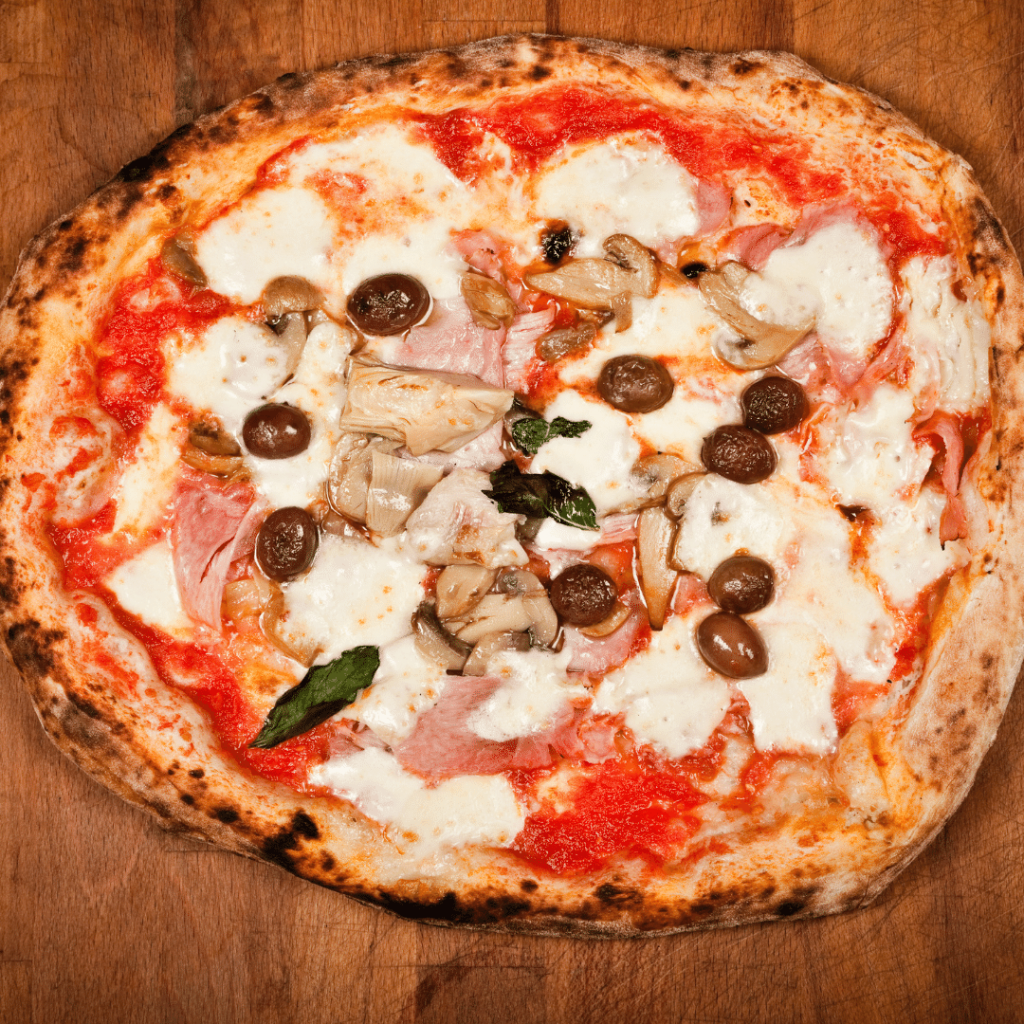
Pizza Capricciosa stands as a testament to the playful and imaginative nature of Italian pizza-making. It’s a pizza that allows for a bit of everything, catering to a wide range of tastes, making it a popular choice for those who want a bit of diversity on their plate.
Pizza Caprese: The Salad Pizza
Pizza Caprese is a refreshing and light culinary creation, directly inspired by the beloved Caprese salad. This pizza version captures the essence of the salad, known for its fresh tomatoes, mozzarella cheese, and basil leaves, all seasoned with the simplest yet most elegant of dressings. It’s a testament to the Italian knack for turning simple ingredients into something extraordinary.
A Tribute to Simplicity and Freshness
The Caprese salad, with its roots in the Campania region, is celebrated for its vibrant colors that resemble the Italian flag. This pizza adaptation brings the same freshness and simplicity to the table, making it a perfect choice for those who appreciate a lighter, more refreshing pizza experience.
The Toppings
- Fresh Tomatoes: Sliced or diced, these juicy, ripe tomatoes provide a burst of freshness and a tangy sweetness that’s quintessentially summer.
- Mozzarella Cheese: Soft, creamy, and subtly tangy, mozzarella adds a rich, velvety texture that complements the acidity of the tomatoes.
- Basil Leaves: Fresh basil, with its peppery and slightly sweet flavor, brings a touch of green and an aromatic freshness that’s integral to the Caprese character.
- Olive Oil: A drizzle of high-quality olive oil enhances the pizza with a fruity and peppery note, binding all the flavors together in harmony.
- Salt and Pepper: A sprinkle of salt and pepper is all that’s needed to elevate the natural flavors of the ingredients, highlighting their freshness and quality.
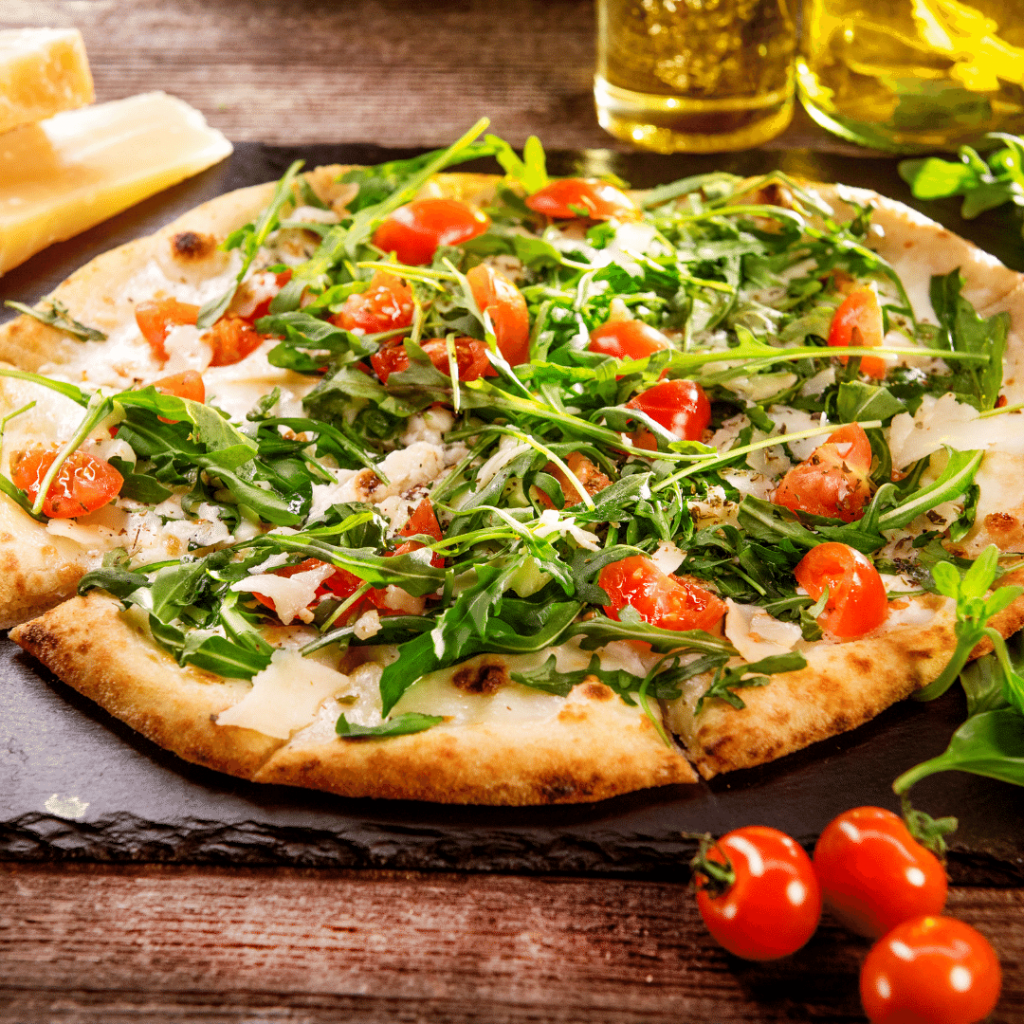
Pizza Caprese is more than just a pizza; it’s a culinary representation of an Italian summer. Each bite takes you to a sunny Mediterranean garden, where the flavors are as vibrant as the scenery. It’s a lighter option that doesn’t compromise on taste or satisfaction.
Pizza Quattro Stagioni: Four Seasons
Pizza Quattro Stagioni, or “Four Seasons Pizza,” is a unique and visually stunning creation that emerged in the 20th century. It’s a delightful representation of the four seasons, with each quarter of the pizza adorned with toppings that symbolize spring, summer, autumn, and winter. This pizza is not just a feast for the palate but also for the eyes, offering a variety of flavors in one harmonious dish.
The concept behind Pizza Quattro Stagioni is both ingenious and artistic. It reflects the Italian love for seasonal ingredients, with each quarter of the pizza dedicated to the bounty of a specific season:
- Spring (Artichokes): Tender and nutty, artichokes represent the freshness and renewal of spring.
- Summer (Tomatoes): Juicy and bright, tomatoes capture the essence of summer’s warmth and abundance.
- Autumn (Mushrooms): Earthy and rich, mushrooms symbolize the depth and bounty of the autumn harvest.
- Winter (Ham): Savory and comforting, ham brings the heartiness and warmth associated with winter.
The Toppings
- Tomato Sauce: Serving as a common base, it unites the diverse flavors with its rich and tangy profile.
- Mozzarella Cheese: This creamy and mild cheese provides a canvas that allows the individual flavors of each topping to stand out.
- Olives: Scattered across the pizza, olives add a hint of brininess, enhancing the overall taste experience.
- Olive Oil: A drizzle of olive oil adds a final touch of richness and ties the diverse flavors together.
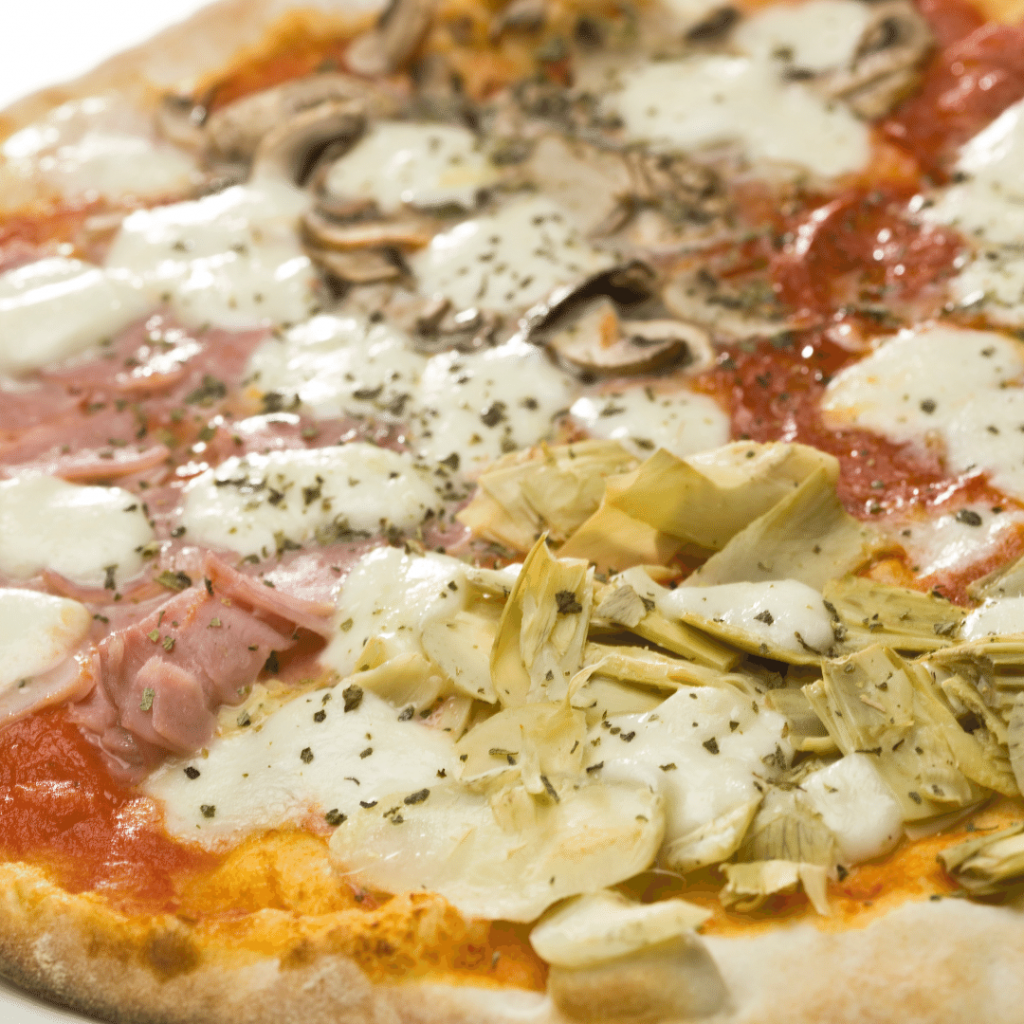
Each slice of Pizza Quattro Stagioni offers a different taste experience, reminiscent of the changing seasons. It’s a pizza that tells a story, taking you on a culinary journey through the year. The careful selection and placement of the toppings ensure that each season’s character is distinct yet part of a greater, harmonious whole.
Pizza Boscaiola: The Woodcutter’s Pizza
Pizza Boscaiola, often referred to as “The Woodcutter’s Pizza,” is a rustic and hearty delight that emerged in the 20th century. This pizza is a homage to the Italian countryside, showcasing toppings that reflect the robust and earthy flavors found in rural areas. It’s a pizza that tells a story of simplicity and tradition, bringing the essence of the forest and countryside to your plate.
The inspiration behind Pizza Boscaiola lies in the simple, yet flavorful ingredients that were readily available to woodcutters and countryside dwellers. These ingredients, which include mushrooms, sausage, and cheese, were often the staples in their diets, providing nourishment and comfort after a hard day’s work in the forests and fields.
The Toppings
- Tomato Sauce: A rich and vibrant base, it adds a tangy depth to the pizza, complementing the heartier toppings.
- Mozzarella Cheese: This classic pizza cheese offers a creamy texture and a mild flavor that balances the more robust toppings.
- Mushrooms: Earthy and meaty, mushrooms are a key ingredient in this pizza, reflecting the woodsy aroma and flavors of the forest.
- Sausage: Providing a spicy and savory kick, the sausage adds a hearty and fulfilling element, reminiscent of the rustic countryside cuisine.
- Parmesan Cheese: A sprinkle of Parmesan brings a salty, nutty accent to the pizza, enhancing the overall depth of flavors.
- Olive Oil: A final drizzle of olive oil gives a smooth finish to the pizza, tying all the rustic flavors together.
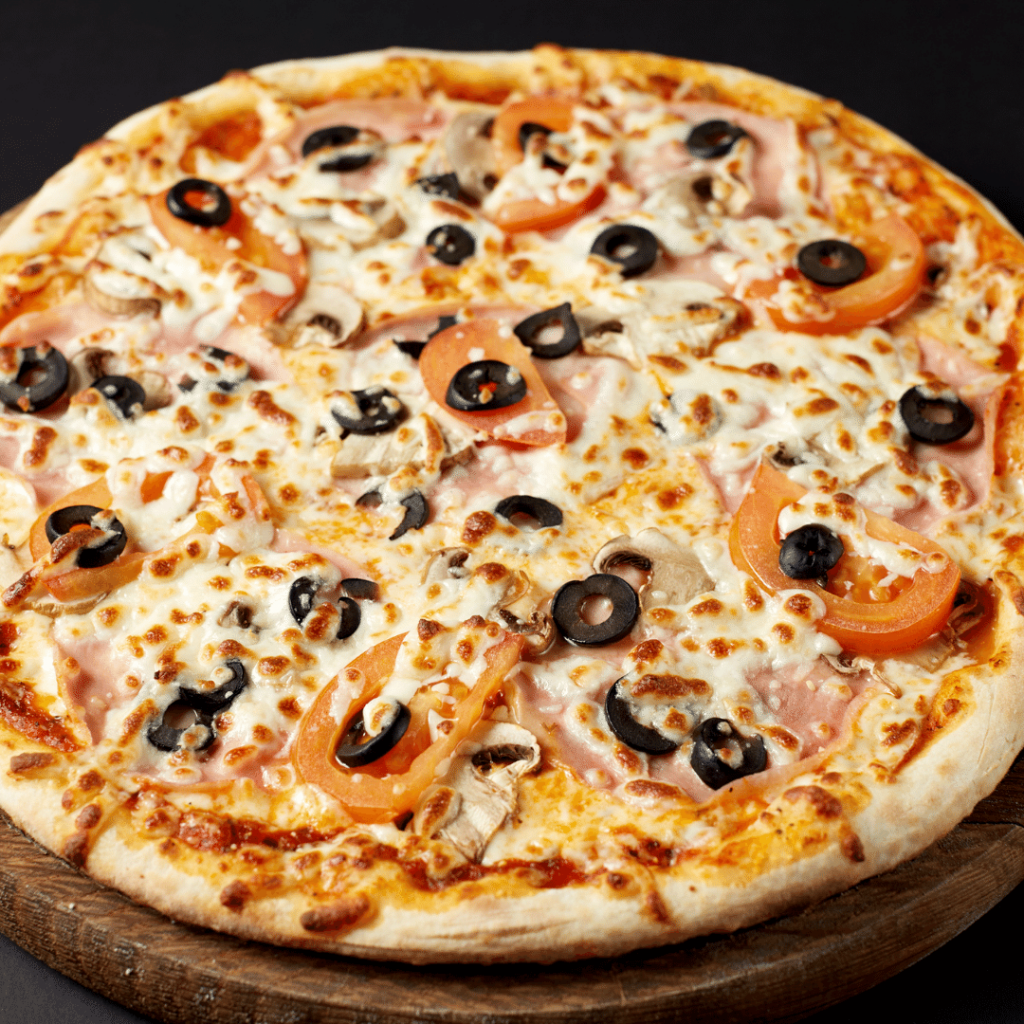
Pizza Boscaiola is a culinary journey into the heart of rural Italy. It’s a pizza that’s both comforting and satisfying, with each ingredient playing a crucial role in creating a symphony of hearty flavors. The combination of mushrooms and sausage, complemented by the richness of the cheeses, makes for a truly fulfilling meal.
Pizza Frutti di Mare: Seafood Pizza
Pizza Frutti di Mare, or Seafood Pizza, is a delicacy that captures the essence of Italy’s coastal regions. This pizza is a tribute to the fresh and abundant seafood available along the Italian coastline, combining the traditional pizza base with a medley of oceanic flavors. It’s a dish that brings the taste of the sea straight to your table.
In the coastal areas of Italy, where the sea is an integral part of daily life, seafood is not just food; it’s a way of life. Pizza Frutti di Mare emerged as a natural extension of this seaside culture, featuring a variety of seafood toppings that are as fresh as the ocean breeze. The combination of these seafood ingredients on a pizza was a culinary innovation that bridged traditional Italian pizza with the bounties of the sea.
The Toppings
- Tomato Sauce: A light layer of tomato sauce serves as the base, offering a subtle tanginess that complements the seafood.
- Garlic: Essential to any seafood dish, garlic adds a pungent, aromatic depth that enhances the ocean flavors.
- Parsley: Fresh parsley brings a burst of herbal brightness, balancing the richness of the seafood.
- Mixed Seafood: The star of the show, this can include a variety of seafood such as clams, mussels, shrimp, squid, and octopus, each contributing its unique texture and flavor.
- Olive Oil: A generous drizzle of olive oil infuses the pizza with a fruity richness, marrying the flavors beautifully.
- Lemon Juice: A squeeze of fresh lemon juice just before serving adds a zesty, refreshing lift that elevates the seafood flavors.
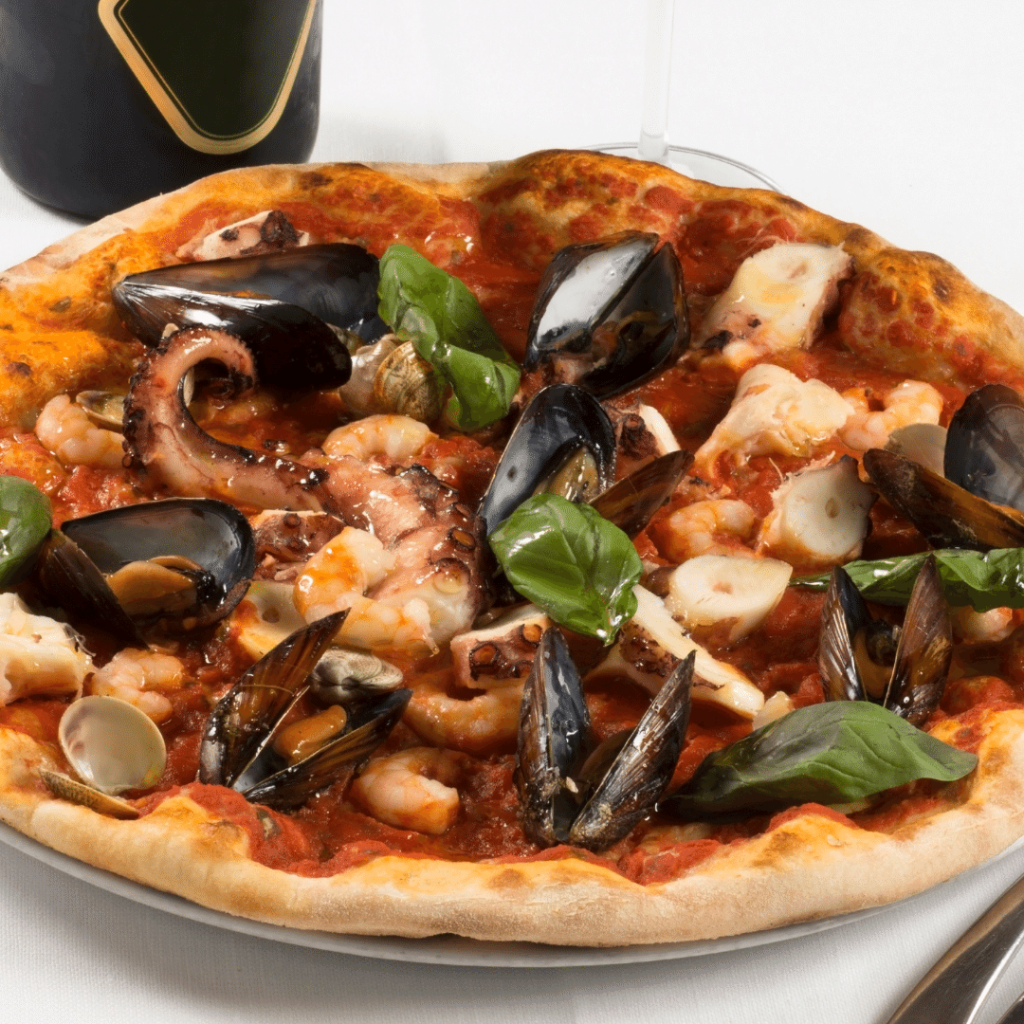
Pizza Frutti di Mare is more than just a seafood dish; it’s an experience. Each bite offers a taste of the Italian seaside, with the various seafood toppings providing a symphony of flavors and textures. The garlic and parsley create a perfect aromatic backdrop, while the lemon juice brings a bright, citrusy finish that complements the richness of the seafood.
Pizza alla Napoletana: The Neapolitan Pizza
Pizza alla Napoletana, or Neapolitan Pizza, stands as the cornerstone of traditional Italian pizza. Originating from Naples, the revered birthplace of pizza, this style epitomizes the essence of what authentic Italian pizza is all about. Characterized by its distinctively thin and soft center, complemented by a puffy, charred cornicione, Neapolitan Pizza is a culinary art form steeped in history and tradition.
Naples, a city synonymous with pizza, gifted the world this traditional pizza style that has since become a benchmark for pizza authenticity. The beauty of Pizza alla Napoletana lies in its simplicity and the high quality of its few ingredients. Its preparation and baking are considered an art, adhering to time-honored techniques that have been passed down through generations.
The Toppings
- Tomato Sauce: Made from ripe, crushed tomatoes, the sauce is bright and tangy, forming the perfect base for the toppings. It’s applied with a light hand to maintain the pizza’s delicate balance.
- Mozzarella Cheese: Fresh mozzarella, preferably mozzarella di bufala, is dotingly placed atop the sauce. Its creamy texture and mild flavor blend seamlessly with the tomato base.
- Basil Leaves: Fresh basil leaves are scattered over the pizza, adding a fragrant, herbal aroma and a splash of green that complements the red and white colors.
- Olive Oil: A drizzle of high-quality olive oil right before baking brings a subtle richness and helps to crisp up the crust, adding an extra dimension to the flavor profile.
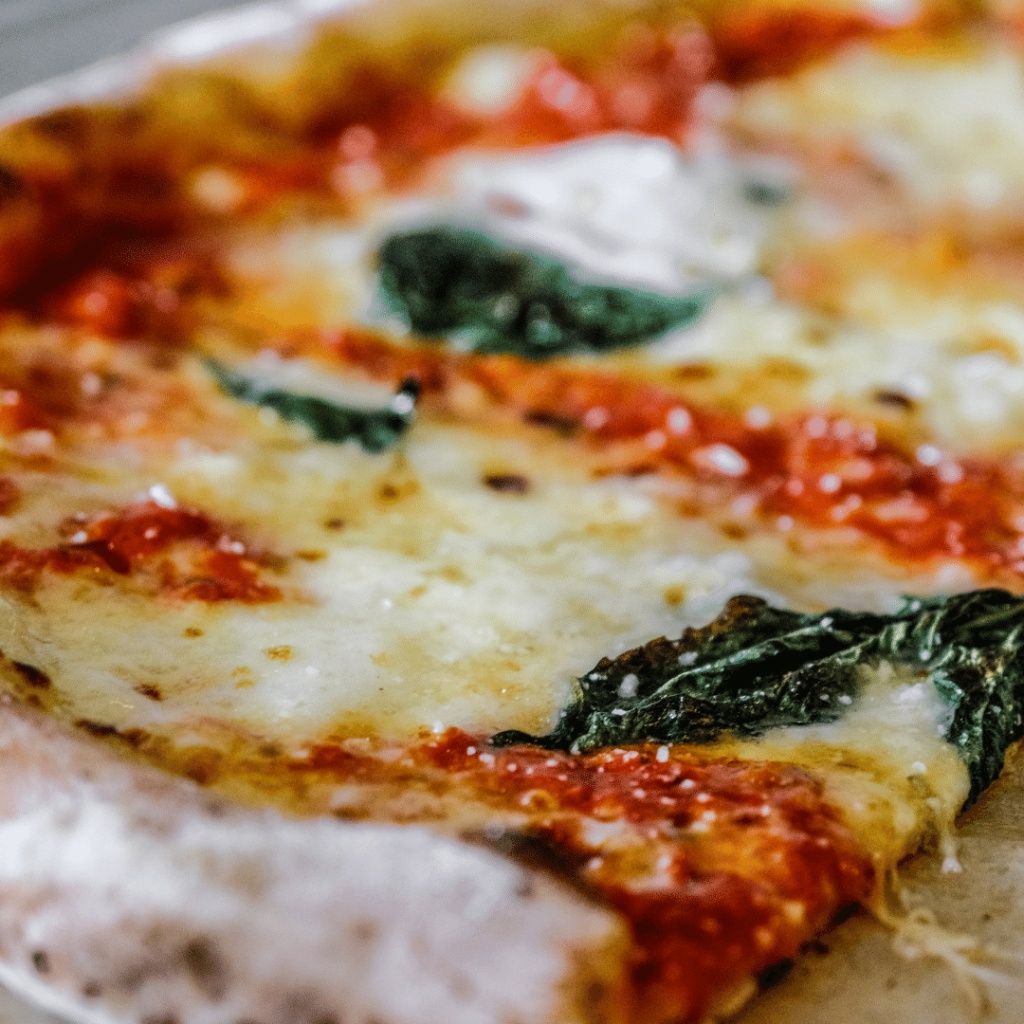
Each element of Pizza alla Napoletana is crucial, from the specific type of wheat flour used for the dough to the way the pizza is expertly baked in a wood-fired oven at high temperatures. This results in a pizza that is both soft and chewy, with a light char on the crust that adds a hint of smokiness. The toppings, though simple, are chosen for their freshness and quality, ensuring that each bite is a harmonious blend of flavors.
Pizza Nduja: The Spicy Spreadable Salami
Pizza Nduja is a contemporary addition to the Italian pizza family, bringing a fiery twist to the traditional pie. Originating in the 21st century, this pizza reflects the growing popularity of nduja – a spicy, spreadable salami hailing from Calabria in Southern Italy. Known for its bold flavors and fiery heat, nduja has become a sought-after topping for those looking to add an extra kick to their pizza.
The introduction of nduja as a pizza topping is a relatively recent culinary innovation, reflecting the evolving tastes and experimental nature of modern Italian cooking. This spicy salami has transformed the pizza experience, offering a unique blend of heat and flavor that is both invigorating and deeply satisfying.
The Toppings
- Tomato Sauce: The base of the pizza features a classic tomato sauce, which provides a tangy and sweet backdrop to the spicy nduja.
- Mozzarella Cheese: As with many traditional pizzas, mozzarella is used for its creamy texture and mild taste, balancing the intensity of the nduja.
- Nduja: The star ingredient, nduja, is generously spread over the pizza. Its fiery heat and rich, meaty flavor make every bite an explosive taste adventure.
- Olive Oil: A drizzle of olive oil not only enhances the overall richness but also helps to marry the bold flavors of the nduja with the more subtle notes of the cheese and tomato sauce.
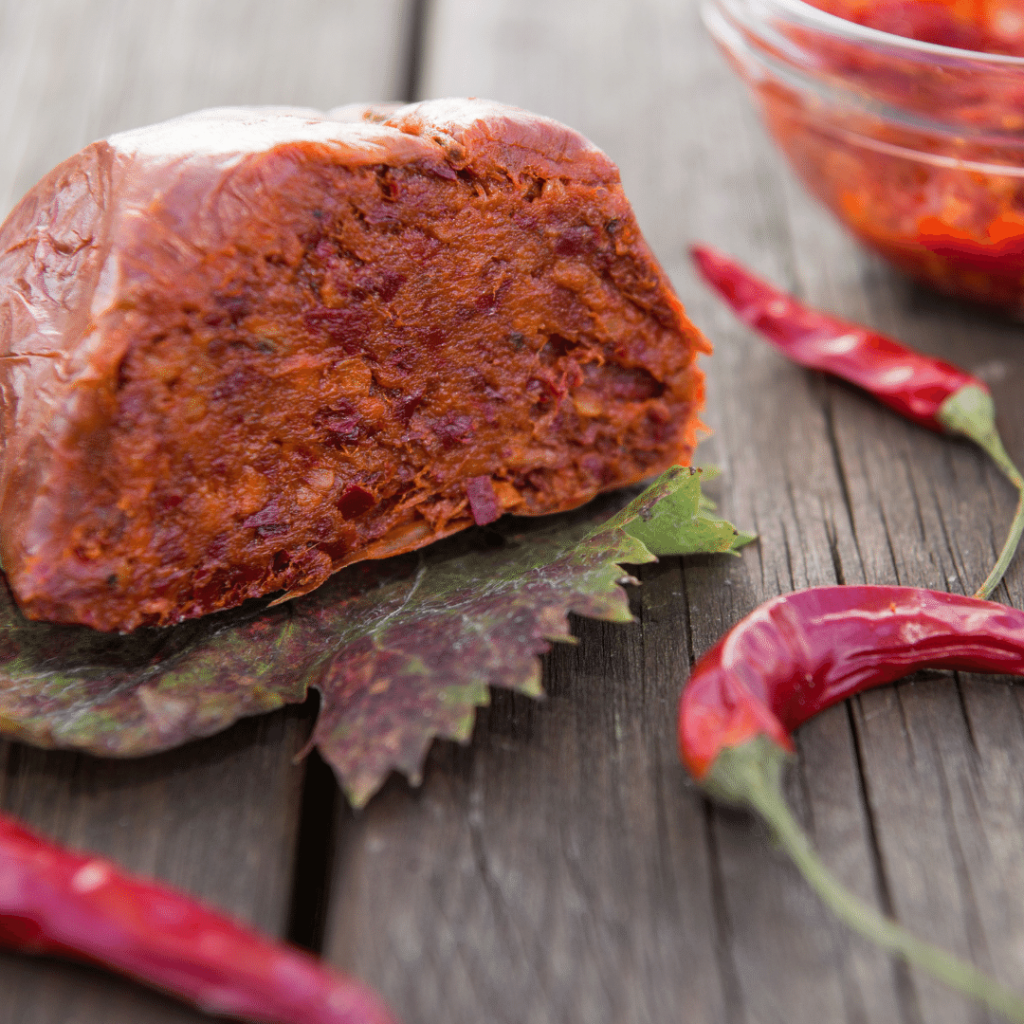
Pizza Nduja is perfect for those who love to push the boundaries of traditional pizza flavors. The nduja’s spicy and robust character makes it a favorite among those who crave a bit more excitement on their pizza. The way the heat from the nduja melds with the creamy mozzarella and the tangy tomato sauce creates a dynamic and unforgettable flavor profile.
Pizza all Salsiccia: The Sausage Pizza
Pizza all Salsiccia, often simply known as Sausage Pizza, is a meat-lover’s dream come true. Originating in the 20th century, this pizza became a staple in Italian and global cuisine, thanks to the widespread availability and popularity of sausage as a topping. Known for its hearty and satisfying nature, Pizza all Salsiccia perfectly combines the rich flavors of sausage with classic pizza ingredients.
The 20th century saw an increase in the availability and variety of sausages, leading to its adoption as a favored pizza topping. Sausages, seasoned with a blend of spices and herbs, offered a new dimension of taste and protein to the traditional pizza, creating a fulfilling and flavorful experience for diners.
The Toppings
- Tomato Sauce: A foundation of rich tomato sauce sets the stage, providing a tangy and sweet contrast to the savory sausage.
- Mozzarella Cheese: Mozzarella brings its trademark creamy and melty quality to the pizza, balancing the rich flavors of the sausage.
- Sausage: The highlight of this pizza, sausage, is generously scattered over the top, offering a burst of savory, spicy, and herbaceous flavors in every bite.
- Olive Oil: A drizzle of olive oil enhances the overall richness and helps to crispen the crust, adding a subtle fruity note.
- Peppers or Onions (Optional): Some variations of Pizza all Salsiccia include peppers or onions, which add a sweet or sharp depth to the pizza, complementing the meatiness of the sausage.
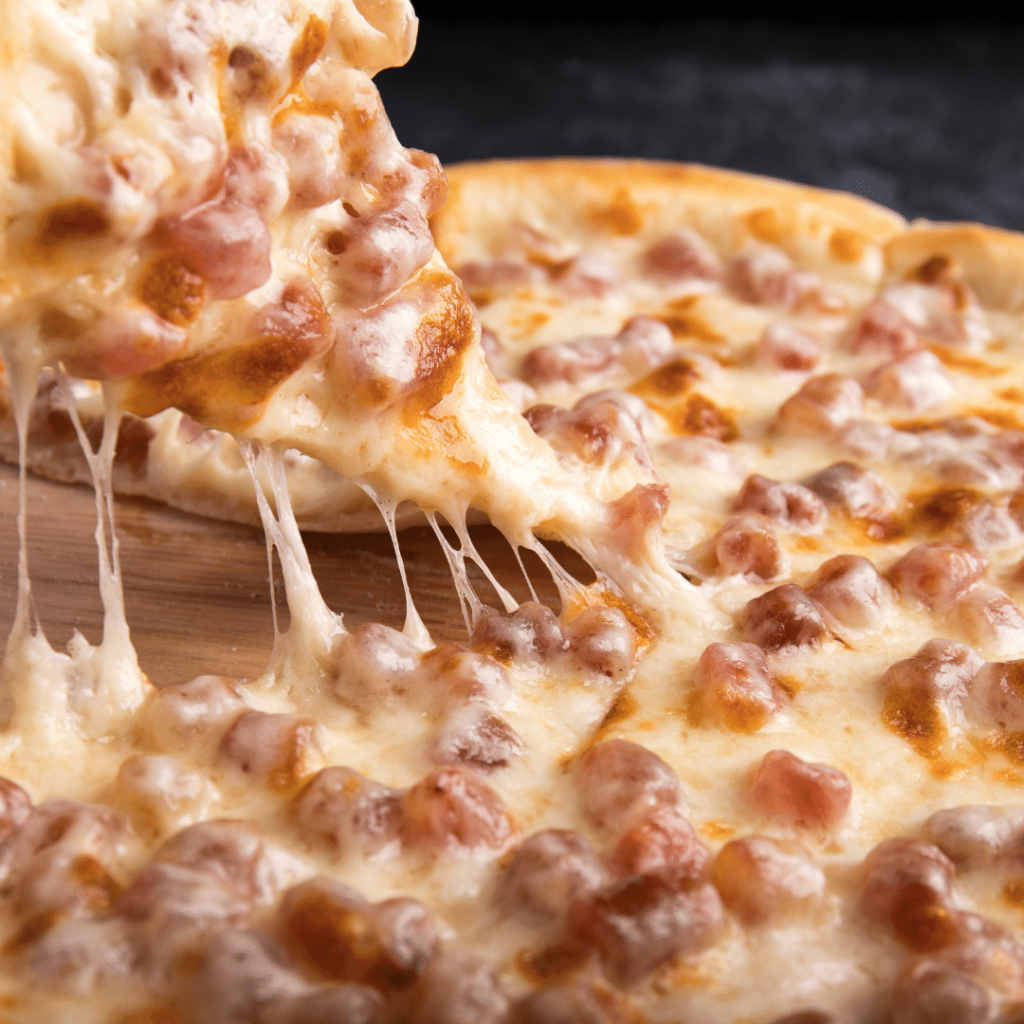
Pizza all Salsiccia is a celebration of robust flavors and hearty textures. The combination of spicy and savory sausage with the smoothness of the cheese and the acidity of the tomato sauce creates a well-rounded and immensely satisfying meal. It’s a pizza that not only fills you up but also leaves you with a memorable taste experience.
Pizza Pugliese: The Apulian Pizza
Pizza Pugliese, hailing from the sun-drenched region of Puglia in Southern Italy, is a regional specialty that encapsulates the essence of Apulian cuisine. Known for its thick, fluffy dough and a harmonious blend of local ingredients, Pizza Pugliese is a delightful representation of the area’s culinary traditions and the abundant produce of this fertile region.
Puglia, with its rich agricultural heritage, is renowned for producing some of Italy’s finest tomatoes, olives, and wheat. Pizza Pugliese is a celebration of these local ingredients, combining them in a way that is both simple and incredibly flavorful. The pizza’s thick, airy dough is a distinct characteristic, providing a satisfyingly chewy base for the toppings.
The Toppings
- Tomato Sauce: A base of homemade tomato sauce offers a sweet and tangy foundation, highlighting the quality of Puglia’s famed tomatoes.
- Mozzarella Cheese: The cheese adds a creamy, melty layer that harmonizes with the other toppings, contributing to the pizza’s overall richness.
- Cherry Tomatoes: Fresh cherry tomatoes, either halved or whole, are scattered atop the pizza, bursting with sweetness and adding a vibrant pop of color.
- Black Olives: A staple in Puglian cuisine, black olives bring a touch of brininess and a hint of bitterness, enhancing the pizza’s depth of flavor.
- Red Onions: Thinly sliced red onions offer a slight sharpness and sweetness, complementing the other ingredients with their subtle pungency.
- Oregano: This aromatic herb is liberally sprinkled over the pizza, infusing it with a classic Mediterranean flavor that is both earthy and slightly peppery.
- Olive Oil: A final drizzle of high-quality olive oil adds a fruity, peppery note and ensures that the crust bakes to a perfect golden brown.
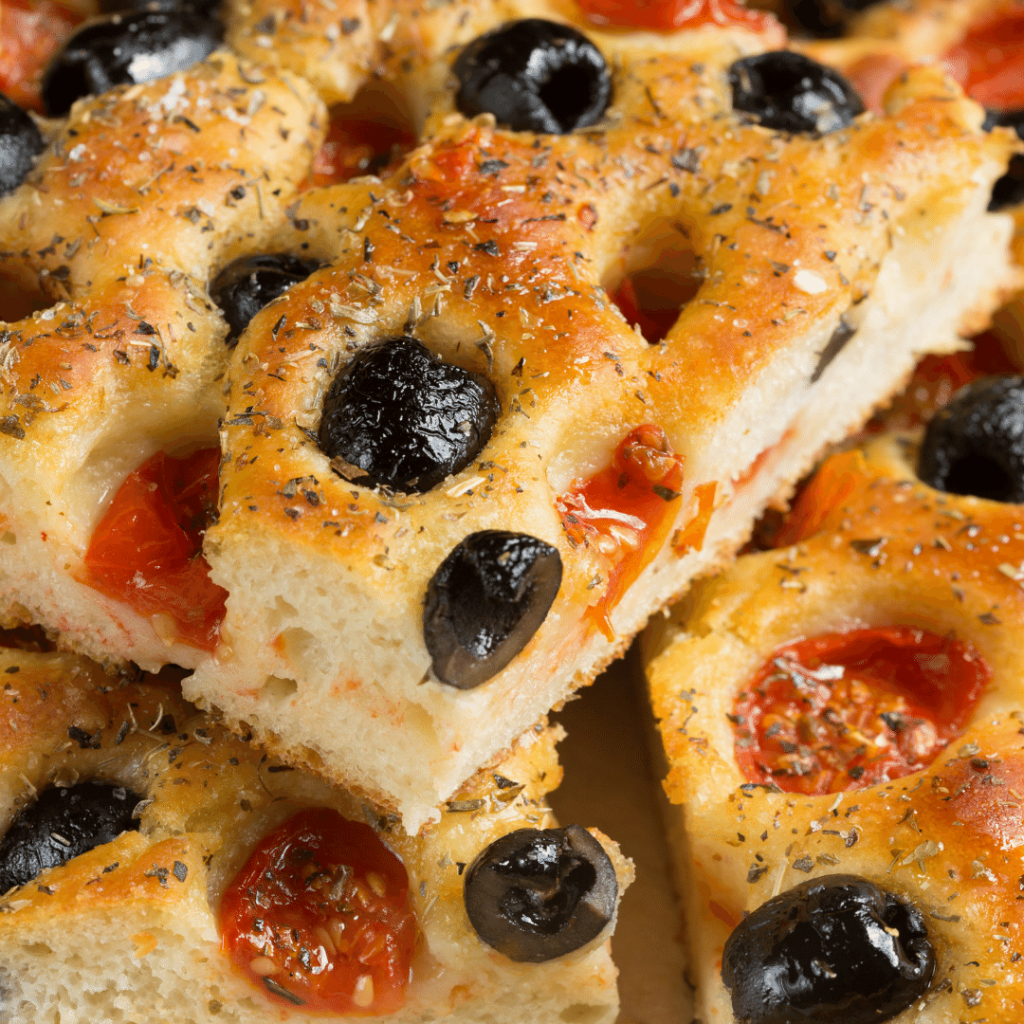
Pizza Pugliese is more than just a regional dish; it’s a culinary journey through the flavors of Puglia. Each ingredient is carefully chosen to represent the region’s agricultural bounty and culinary traditions. The result is a pizza that is not only deeply satisfying but also a beautiful showcase of local flavors and textures.
Pizza Melanzane: The Eggplant Pizza
Pizza Melanzane, also known as Eggplant Pizza, is a delightful vegetarian option that emerged in the 20th century. Celebrating the humble eggplant, this pizza showcases the versatility and rich flavors of this purple vegetable. The eggplant’s unique soft and smoky profile adds a distinct texture and a burst of color, making it a popular choice for those seeking a meat-free yet flavorful pizza experience.
The inclusion of eggplant as a pizza topping was a culinary innovation, highlighting the versatility of this vegetable in Italian cooking. Eggplants, with their meaty texture and ability to absorb flavors, became a natural choice for pizza, offering a satisfying alternative to traditional meat toppings.
The Toppings
- Tomato Sauce: The base layer of tomato sauce lends a tangy and sweet flavor, complementing the smokiness of the eggplant.
- Mozzarella Cheese: A layer of mozzarella adds a creamy, melty texture, creating a perfect canvas for the eggplant.
- Eggplant: Sliced or diced, the eggplant is the star of this pizza. It’s often pre-roasted or grilled to enhance its natural smoky flavor and soft texture.
- Olive Oil: A generous drizzle of olive oil not only enriches the flavor but also helps in crisping the eggplant and achieving a golden crust.
- Parmesan Cheese or Basil Leaves (Optional): Some variations of Pizza Melanzane include a sprinkle of Parmesan cheese for a salty, nutty kick, or fresh basil leaves for an aromatic freshness.
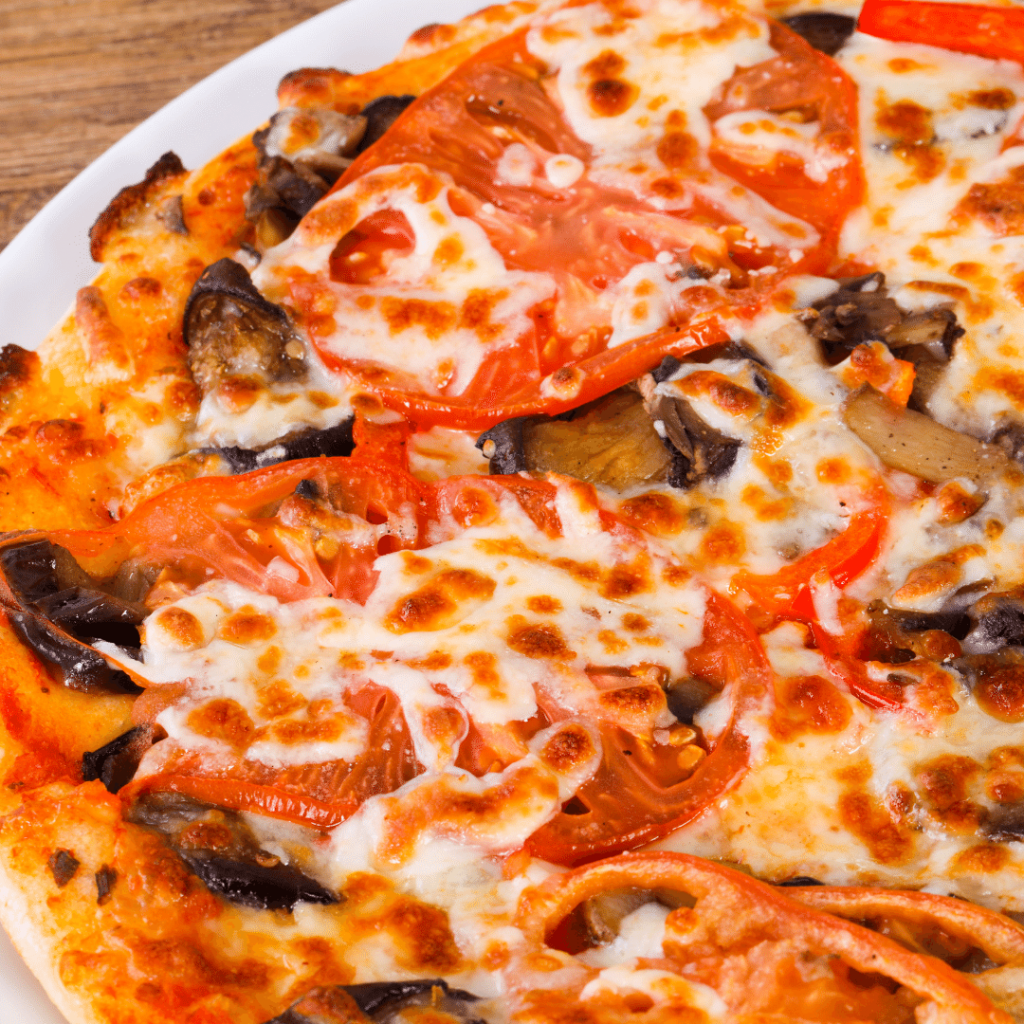
Pizza Melanzane is a celebration of the flavors and textures that can be achieved with plant-based ingredients. The eggplant, with its unique smokiness and tender texture, offers a delightful contrast to the creamy cheese and the vibrant tomato sauce. This pizza is not only a vegetarian delight but also a choice for anyone looking to explore the diverse world of pizza toppings.
Pizza Prosciutto Crudo e Rucola: The Ham and Rocket Pizza
Pizza Prosciutto Crudo e Rucola is a culinary creation that epitomizes elegance and freshness in the world of pizza. Originating in the 20th century, this pizza combines the delicate flavors of prosciutto crudo, a thinly sliced cured ham, with the peppery zest of rucola (also known as arugula or rocket). The result is a sophisticated and refreshing pizza, perfect for those seeking a lighter yet flavorful option.
The introduction of prosciutto crudo and rucola as pizza toppings was a nod to the evolving Italian palate, which began to embrace a combination of delicate and bold flavors. This pizza is all about contrast and balance, bringing together the salty, savory taste of the ham with the sharp, peppery notes of the rucola.
The Toppings
- Tomato Sauce: A simple tomato sauce forms the base, offering a sweet and tangy backdrop that complements the toppings.
- Mozzarella Cheese: The mozzarella provides a creamy, mild foundation that allows the flavors of the prosciutto and rucola to shine.
- Prosciutto Crudo: Thinly sliced and delicate, prosciutto crudo adds a luxurious, savory depth to the pizza.
- Rucola: Fresh rucola is added after baking, providing a crisp, peppery kick that elevates the pizza’s flavor profile.
- Olive Oil: A drizzle of olive oil enhances the overall richness and helps meld the flavors together beautifully.
- Parmesan Cheese or Balsamic Vinegar (Optional): Some variations include a sprinkle of Parmesan for a nutty, salty accent or a drizzle of balsamic vinegar for a sweet and tangy finish.

Pizza Prosciutto Crudo e Rucola is not just a pizza; it’s a culinary work of art. The combination of prosciutto and rucola creates a play of textures and flavors that is both refined and satisfying. It’s a pizza that appeals to those with a taste for the finer things in life, offering a gourmet experience that is both indulgent and refreshingly light.
Regional Variations and Modern Interpretations
The world of Italian pizza is rich and varied, with each region of Italy bringing its own unique flavors and traditions to this beloved dish. These regional variations are deeply influenced by local geography, climate, culture, and history, leading to a fascinating diversity in pizza toppings across the country. In recent years, modern interpretations have also emerged, blending traditional Italian techniques with global flavors and ingredients.
Regional Specialties in Pizza Toppings
- Pizza al Taglio (Central Italy, including Rome): Known for its convenience of being sold by the slice, Pizza al Taglio features a thin and crispy crust. The toppings vary widely, including potatoes, zucchini, egg, sausage, and different types of cheese, reflecting the diverse culinary influences of central Italy.
- Pizza Siciliana (Sicily): This pizza is distinguished by its thick, fluffy crust, often with a layer of cheese beneath the tomato sauce. Toppings like anchovies, capers, olives, and breadcrumbs are common, showcasing Sicily’s rich maritime history and its abundance of fresh produce.
- Pizza Fritta (Naples): A unique take from the birthplace of pizza, Pizza Fritta involves deep-frying the dough before adding toppings like tomato sauce, cheese, ham, ricotta, or salami. This style offers a deliciously different texture and is a testament to Naples’ innovative spirit in pizza making.
- Pizza al Padellino (Turin and Northern Italy): In northern Italy, particularly Turin, pizzas are often baked in small, round pans. The dough gets a nice crust, topped with cheese, tomato sauce, and a variety of ingredients such as mushrooms, sausage, or artichokes, reflecting the northern palate and culinary traditions.
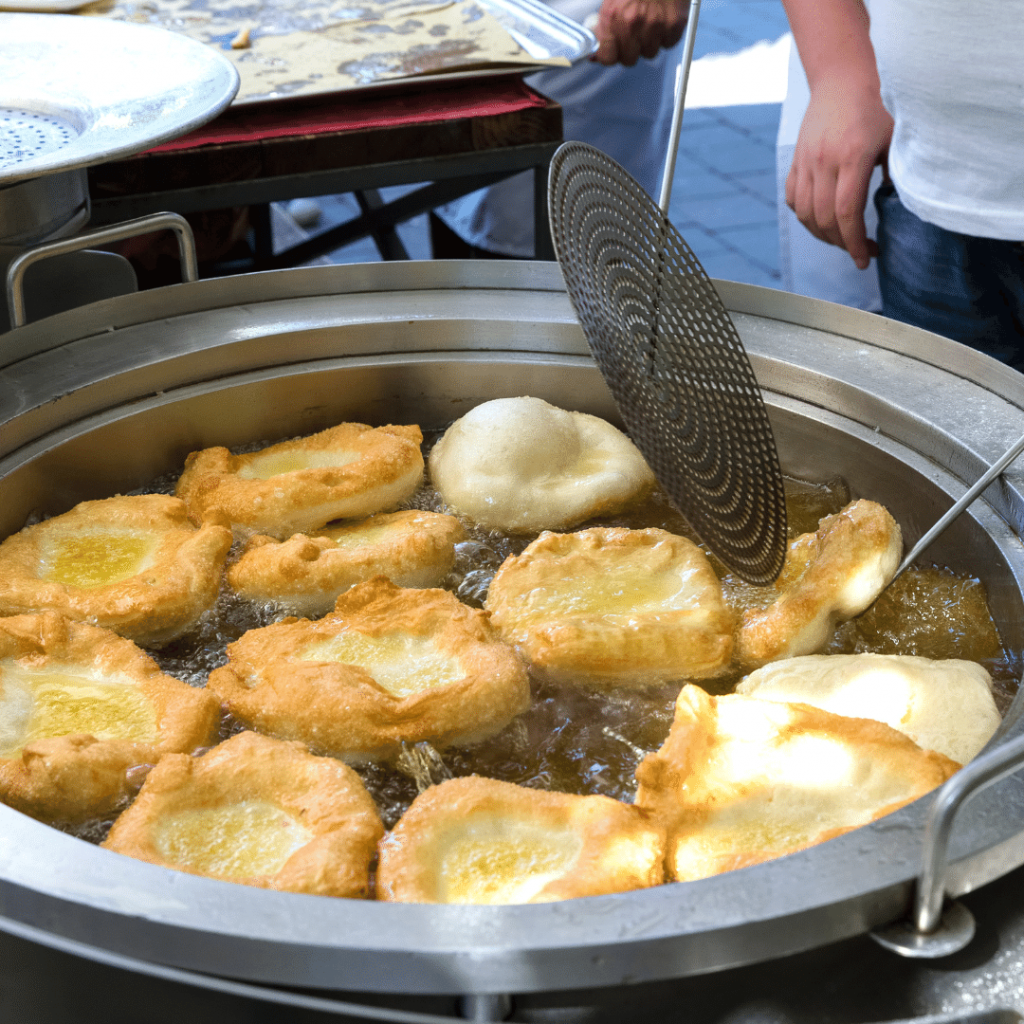
Modern Interpretations and Global Influences
- Pizza al Tartufo: Truffle pizza has become a luxurious modern creation, featuring rare and aromatic truffles. Often paired with rich cheeses like mozzarella, parmesan, or gorgonzola, this pizza is a gourmet experience that combines traditional Italian ingredients with high-end luxury.
- Pizza al Salmone: Incorporating smoked salmon, a delicacy from northern Europe, this pizza is often accompanied by cheeses like mozzarella, cream cheese, or mascarpone, and herbs like dill, parsley, or chives. It’s a fusion that brings a touch of the northern seas to the Italian pizza.
- Pizza al Kebab: Reflecting the influences of Middle Eastern cuisine, this pizza features kebab meat, combined with cheeses such as mozzarella, feta, or halloumi, and sauces like yogurt, hummus, or tahini. It’s a perfect example of how global flavors can be seamlessly integrated into traditional Italian pizza.
- Pizza al Curry: A nod to Indian cuisine, this innovative pizza uses curry spices, paired with cheeses like mozzarella, cheddar, or paneer, and a variety of toppings such as chicken, lamb, or vegetables. It’s a bold and flavorful fusion that highlights the versatility of pizza as a global dish.
Pairing Toppings: The Art of Combination
Creating the perfect pizza is an art, particularly when it comes to pairing toppings. The right combination can elevate a simple pizza to a culinary masterpiece. It’s all about finding the perfect balance of flavors, textures, and colors, ensuring each bite is a harmonious experience. Let’s dive into the basic principles of pairing toppings and explore some classic and innovative combinations.
Principles of Topping Pairing
- Contrast: This involves mixing flavors that are opposites on the taste spectrum, such as sweet and salty or sour and spicy. Contrasting flavors create a complex and intriguing taste experience that can tantalize the taste buds in unexpected ways.
- Complement: Complementary pairings focus on similar flavors that naturally go well together, enhancing each other without overpowering. This might include combining various types of cheese or pairing tomatoes with tomato-based sauces.
- Balance: This principle is about mixing different textures to create a pizza that’s enjoyable to eat. A combination of soft and crunchy, chewy and crispy, or smooth and chunky toppings can add depth and interest to each bite.
- Enhance: A visually appealing pizza is just as important as a tasty one. Enhancing the visual appeal often involves contrasting colors that make the pizza more inviting and appetizing.
Examples of Topping Pairings
- Cheese and Pineapple: A classic example of sweet and salty contrast. The juicy, sweet pineapple complements the salty, creamy cheese, while the soft texture of the cheese contrasts with the juicy crunch of pineapple. The yellow of the pineapple against the white of the cheese also makes for a visually appealing pizza.
- Tomato and Basil: This is a complementary pairing where the fresh, herbal flavor of basil enhances the tangy, sweet taste of tomato sauce. The smooth texture of the sauce is balanced by the leafy, crisp basil, and the red of the tomato sauce against the green basil is visually striking.
- Salami and Peppers: A mix of spicy and sweet flavors, where the chewy, spicy salami is balanced by the crunchy, sweet peppers. The reds and yellows of the peppers add a vibrant visual element to the pizza.
- Mushroom and Gorgonzola: Earthy mushrooms complement the strong, pungent flavor of gorgonzola cheese. The soft texture of the mushrooms contrasts with the crumbly texture of the cheese, and the brown of the mushrooms against the blue-tinged gorgonzola adds a unique color palette to the pizza.
The Future of Italian Pizza Toppings
The future of Italian pizza toppings is an exciting landscape, shaped by evolving tastes, health consciousness, environmental concerns, and a spirit of innovation and experimentation. This evolution reflects a broader shift in consumer preferences and culinary creativity, leading to a diverse and intriguing array of topping options.
Influencing Factors in Emerging Pizza Toppings
- Health and Sustainability: There’s a growing trend towards toppings that are not only healthier but also more sustainable. This shift is in response to increasing awareness of the environmental impact of food production and a rising interest in personal wellness.
- Diversity and Creativity: As global cuisine becomes more accessible, people are more open to experimenting with diverse and unconventional toppings. This trend is driven by curiosity and a desire to explore new culinary horizons.
Examples of Emerging Trends and Innovative Toppings
- Vegan and Vegetarian Toppings: Plant-based diets are on the rise, leading to an increased demand for vegan and vegetarian pizza toppings. Ingredients like vegan cheese, tofu, seitan, tempeh, and jackfruit are becoming popular, along with a variety of vegetables, fruits, nuts, and seeds. These options cater to health-conscious consumers and those looking to reduce their environmental footprint.
- Organic and Local Toppings: There’s a growing preference for organic and locally sourced ingredients. Organic tomatoes, cheese, and meat, as well as local delicacies like truffles, chestnuts, and honey, are sought after for their quality, freshness, and support of local economies.
- Ethnic and Fusion Toppings: The fusion of different culinary traditions is leading to exciting new pizza varieties. Ethnic and fusion toppings bring together flavors from Mexican, Thai, Japanese, Moroccan, and other cuisines. Innovative combinations like pizza sushi, pizza burgers, or pizza tacos are examples of this trend, offering a novel dining experience that blends different culinary cultures.
- Experimental and Unusual Toppings: Adventurous eaters and chefs are pushing the boundaries with experimental toppings. From sweet options like chocolate, ice cream, and marshmallows to more daring choices like insects, these unusual toppings are about having fun and challenging conventional taste preferences. Combinations like pizza with Nutella, pizza with fries, or pizza with popcorn cater to those looking for a unique and playful eating experience.
Italian Pizza Toppings FAQs
What are the most traditional toppings found on an Italian pizza?
Traditional Italian pizza toppings include tomato sauce, mozzarella cheese, fresh basil, olive oil, and in some cases, toppings like anchovies, capers, and prosciutto crudo. The focus is on simplicity and high-quality ingredients.
Is pineapple a common topping on Italian pizzas?
Pineapple is not a traditional topping on Italian pizzas. It’s more commonly found on American-style pizzas. In Italy, the emphasis is on local and traditional ingredients.
However, the debate around pineapple as a pizza topping is a heated one in culinary circles. For a deeper exploration of this topic, see our detailed analysis on Does Pineapple Belong On Pizza?.
What kind of cheese is typically used on Italian pizzas?
The most common cheese used on Italian pizzas is mozzarella, particularly fresh mozzarella or mozzarella di bufala. Other cheeses like Parmesan, Gorgonzola, and Ricotta are also used, depending on the pizza variety.
Are meat toppings popular on Italian pizzas?
Yes, meat toppings are quite popular. Traditional Italian pizzas may feature meats such as prosciutto crudo, salami, sausage (salsiccia), and sometimes ham (prosciutto cotto).
What makes Neapolitan pizza toppings unique?
Neapolitan pizza toppings are unique due to their simplicity and quality. Classic toppings include tomato sauce, mozzarella cheese, fresh basil, and a drizzle of olive oil. The emphasis is on using fresh, high-quality ingredients.
Can I find vegetarian options in Italian pizza toppings?
Absolutely. Many traditional Italian pizzas are naturally vegetarian, such as the Margherita or the Marinara. Additionally, toppings like vegetables, cheese, and herbs offer numerous vegetarian options.
Are there any seafood toppings traditionally used on Italian pizzas?
Yes, seafood toppings like anchovies are traditional on some Italian pizzas, such as Pizza Marinara. Additionally, in coastal regions, you may find pizzas topped with fresh seafood like shrimp, mussels, or squid.
How are modern trends affecting Italian pizza toppings?
Modern trends are introducing more diverse and international ingredients into Italian pizza toppings. This includes vegan and vegetarian options, organic and locally-sourced ingredients, and fusion or ethnic toppings that blend different culinary traditions.
Is it common to use spicy toppings on Italian pizza?
While not traditional in all regions, spicy toppings like chili flakes and spicy salami (like on Pizza Diavola) are used on some Italian pizzas, especially for those who enjoy a bit of heat.
Are there any unique regional toppings specific to certain areas of Italy?
Yes, many regions in Italy have their unique toppings that reflect local ingredients and culinary traditions. For example, in Sicily, you might find Pizza Siciliana with toppings like sardines and breadcrumbs, while in Naples, Pizza Napoletana often features simple, fresh ingredients.

